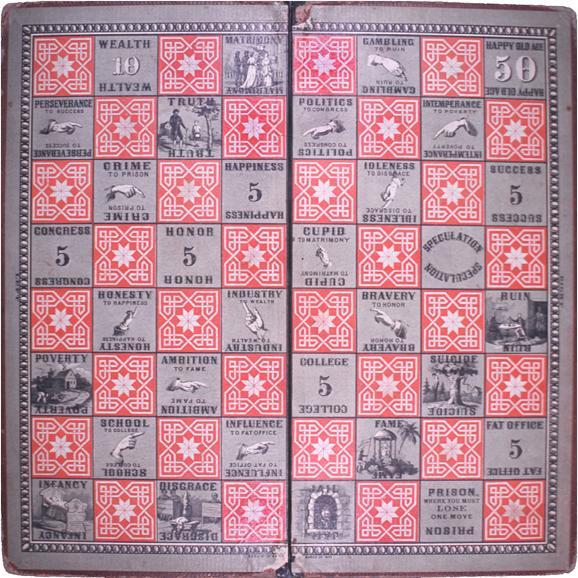Game of Life
A game of chance and fate
This game is played in a special room in Tony's Pizza. Each player first traces their past and then can explore their future. The nature of this future is the subject of many theories. The four biggest theories are ...
When the death scythe shows the die has no effect. However, if both dice show the Death Scythe the player has to pick up a Fate card.
- ... that the game predicts the players future.
- ... that the game shows a potential future of the player. And only with the right choices can it be achieved.
- ... that the game actually affects the fate of the players.
- ... that the game does not actually predict the future, but wants to give players to courage to change their path.
Board & Components
Each player gets a piece to represent them on the board. The board displays a winding path with many splits and crossroads. All paths eventually lead to the end of life, but for some players, the game does not end there. The game is played with two seven-sided dice. Each side has either a number or a symbol and the two dice are different.Fate Die
For each fate die the player can pick up a card from the general deck. The effect of the card depends on the outcome of the dice-roll.- Enlightenment ( ): The player learns something new about themselves or the world.
- Setback ( ): The player has a setback in their life.
- Luck ( ): The player has a lucky break.
- Fate ( ): The player has a fateful encounter.
- Victory ( ): The player achieves something in their life.
- Danger ( ): The player has a dangerous encounter.
- Death ( ): The player has a brush with death.
Advancement Die
This die determines the movement on the board.- Backward ( ): The player chooses to move one field back or return to the last split or crossroad.
- Forward ( ): The player chooses to advance one, two or three fields.
- Choose Direction ( ): The player can either advance Forward or Backward.
- Re-roll ( ): Re-roll both dice again after applying the Fate die.
- Trapped ( ): The player cannot move this turn.
- Superpowers ( ): The player can advance twice next turn and choose a direction this turn.
- Death ( ): The player has a brush with death.
Fate Cards
The fate cards are written in riddles. The card tells of a crossroad in the players future, a decision they have to make. This decision will have a major impact on how their life will progress. When riddle simply hints at a broad outcome of the decision in question. It may be loosing a relationship, winning great fortunes or death. In some cases the cards reveal the players death. When this happens the players piece is advanced to the end zone. The card can give a hint to the player on how their death will occure. In addition to the riddle the fate card also carries an instruction for the board game itself.General Cards
The general cards represent an aspect of life. Each card is then combined with the outcome of the fate die. The general cards are Job, Education, Love, Family, Friendship, Competition and Asset. The players can then interpret the effect of this card on their life and what it could mean.Rules
A round of the game is played as the players are seated around the table. Each player gets to throw the dice once, unless they roll a re-roll. Then they take the action that the dice and cards indicate to them. The game ends once the a player is stuck on the death field for an entire round. The players still alive can continue playing or choose to leave the game. The player who has died has to leave the room and may never return. Players who leave ahead of time will not be able to return either.
Primary Related Location



What a creative game! I also love how people don't know if the game causes your fate or just predicts it.
Adazuri: A shonen-inspired magitech fantasy world home-brewed for 5e.
Thank you for your comment! Glad it works... I rewrote that several times because I didn't know what to do with it ;) And love your world!